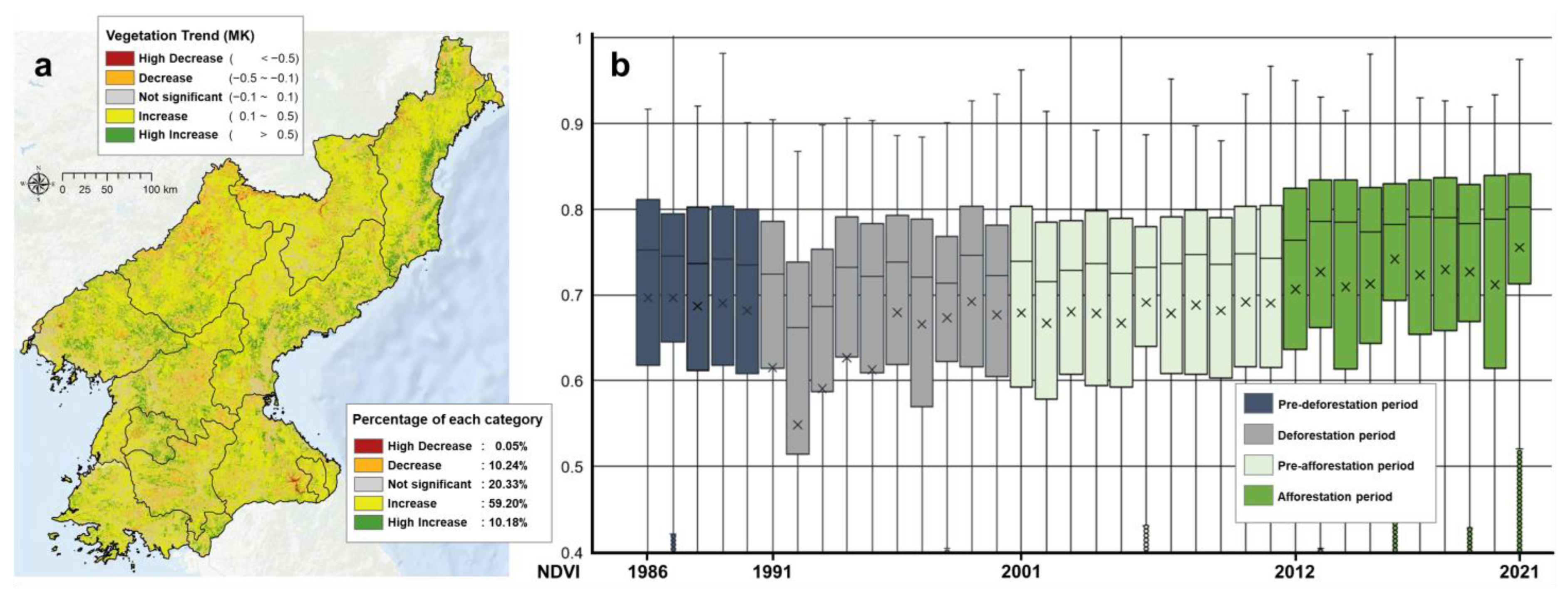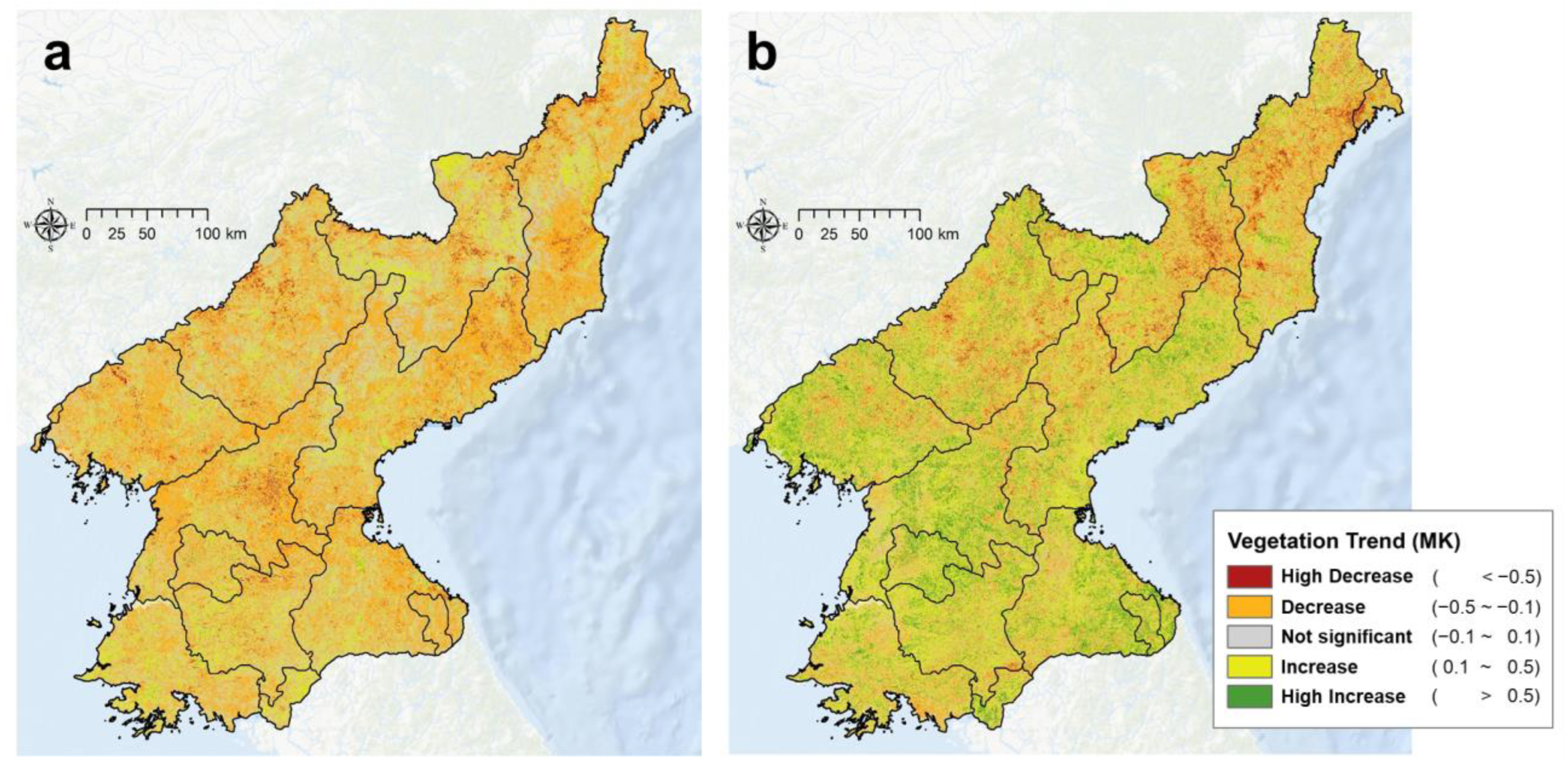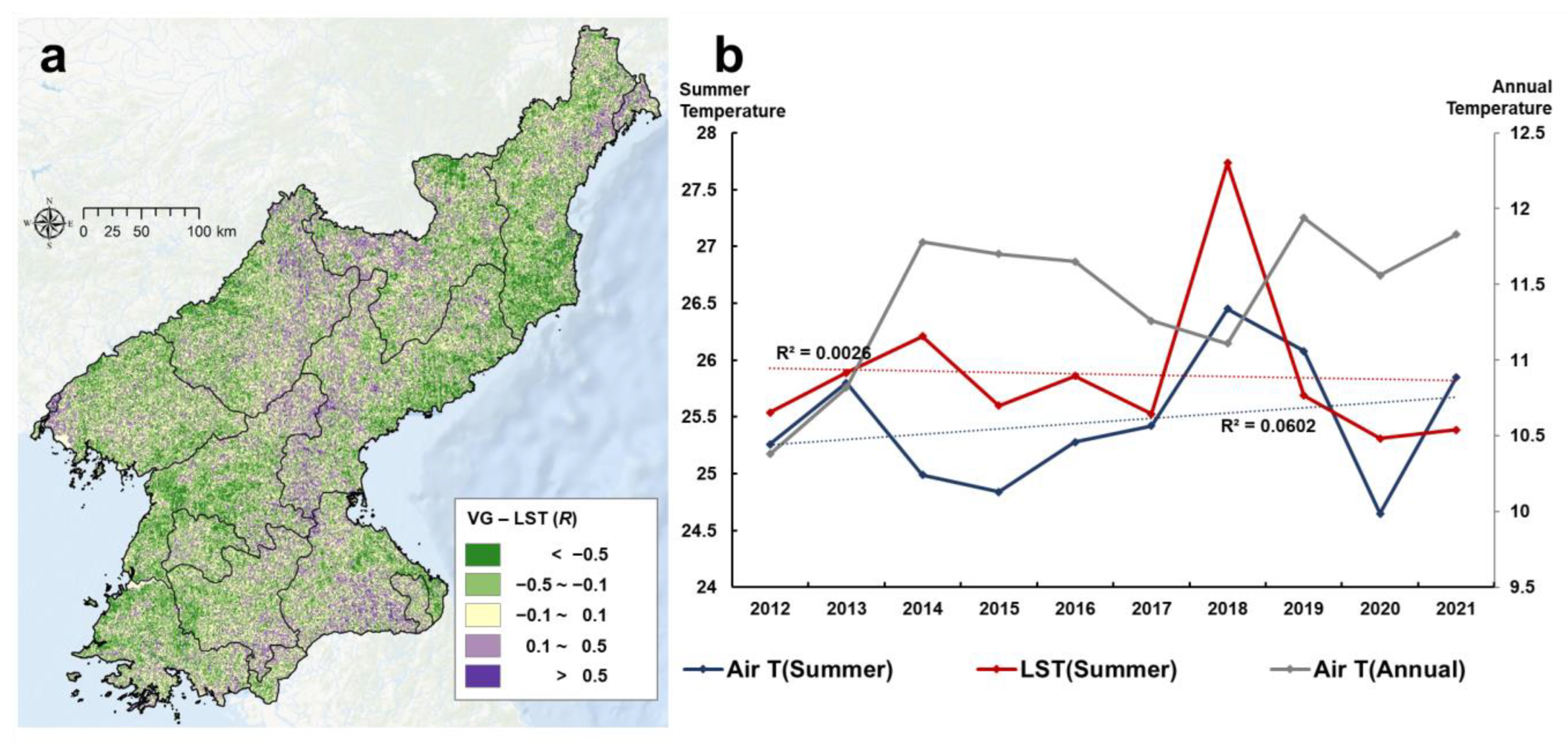Understanding the Long-Term Vegetation Dynamics of North Korea and Their Impact on the Thermal Environment
Abstract
:1. Introduction
2. Data and Methods
2.1. Study Area
2.2. Data
2.2.1. Satellite-Based Vegetation Data
2.2.2. Satellite-Based Land Surface Temperature Data and Meteorological Data
2.3. Methods
3. Results and Discussion
3.1. Long-Term Spatial Trend of North Korean Vegetation
3.2. Vegetation Dynamics on Deforestation and Afforestation Period
3.3. Relationship to Land Surface Temperature
3.4. Implications and Limitations
4. Conclusions
Author Contributions
Funding
Institutional Review Board Statement
Informed Consent Statement
Data Availability Statement
Conflicts of Interest
References
- Seidl, R.; Schelhaas, M.J.; Rammer, W.; Verkerk, P.J. Increasing forest disturbances in Europe and their impact on carbon storage. Nat. Clim. Chang. 2014, 4, 806–810. [Google Scholar] [CrossRef] [Green Version]
- Law, B.E.; Hudiburg, T.W.; Berner, L.T.; Kent, J.J.; Buotte, P.C.; Harmon, M.E. Land use strategies to mitigate climate change in carbon dense temperate forests. Proc. Natl. Acad. Sci. USA 2018, 115, 3663–3668. [Google Scholar] [CrossRef] [PubMed] [Green Version]
- Kim, G.S.; Lim, C.-H.; Kim, S.J.; Lee, J.; Son, Y.; Lee, W.-K. Effect of national-scale afforestation on forest water supply and soil loss in South Korea, 1971–2010. Sustainability 2017, 9, 1017. [Google Scholar] [CrossRef] [Green Version]
- Zanchi, G.; Brady, M.V. Evaluating the contribution of forest ecosystem services to societal welfare through linking dynamic ecosystem modelling with economic valuation. Ecosyst. Serv. 2019, 39, 101011. [Google Scholar] [CrossRef]
- Lee, J.; Lim, C.H.; Kim, G.S.; Markandya, A.; Chowdhury, S.; Kim, S.J.; Son, Y. Economic viability of the national-scale forestation program: The case of success in the Republic of Korea. Ecosyst. Serv. 2018, 29, 40–46. [Google Scholar] [CrossRef]
- Tegegne, Y.T.; Cramm, M.; Van Brusselen, J.; Linhares-Juvenal, T. Forest Concessions and the United Nations Sustainable Development Goals: Potentials, Challenges and Ways Forward. Forests 2019, 10, 45. [Google Scholar] [CrossRef] [Green Version]
- Lim, C.-H. Water-centric nexus approach for the agriculture and forest sectors in response to climate change in the Korean Peninsula. Agronomy 2021, 11, 1657. [Google Scholar] [CrossRef]
- Richards, D.R.; Thompson, B.S.; Wijedasa, L. Quantifying net loss of global mangrove carbon stocks from 20 years of land cover change. Nat. Commun. 2020, 11, 4260. [Google Scholar] [CrossRef]
- Hansen, M.C.; Potapov, P.V.; Moore, R.; Hancher, M.; Turubanova, S.; Tyukavina, A.; Loveland, T. High-resolution global maps of 21stcentury forest cover change. Science 2013, 342, 850–853. [Google Scholar] [CrossRef] [Green Version]
- Keenan, R.J.; Reams, G.A.; Achard, F.; de Freitas, J.V.; Grainger, A.; Lindquist, E. Dynamics of global forest area: Results from the FAO Global Forest Resources Assessment 2015. For. Ecol. Manag. 2015, 352, 9–20. [Google Scholar] [CrossRef]
- Stabile, M.C.; Guimarães, A.L.; Silva, D.S.; Ribeiro, V.; Macedo, M.N.; Coe, M.T.; Pinto, E.; Moutinho, P.; Alencar, A. Solving Brazil’s land use puzzle: Increasing production and slowing Amazon deforestation. Land Use Policy 2020, 91, 104362. [Google Scholar] [CrossRef]
- Hoang, N.T.; Kanemoto, K. Mapping the deforestation footprint of nations reveals growing threat to tropical forests. Nat. Ecol. Evol. 2021, 5, 845–853. [Google Scholar] [CrossRef]
- Lim, C.H.; Choi, Y.; Kim, M.; Jeon, S.W.; Lee, W.K. Impact of deforestation on agro-environmental variables in cropland, North Korea. Sustainability 2017, 9, 1354. [Google Scholar] [CrossRef] [Green Version]
- Lim, C.H.; Song, C.; Choi, Y.; Jeon, S.W.; Lee, W.K. Decoupling of forest water supply and agricultural water demand attributable to deforestation in North Korea. J. Environ. Manag. 2019, 248, 109256. [Google Scholar] [CrossRef] [PubMed]
- Choi, H.A. Prospect and Implementation Strategy of the Inter-Korean Forest Cooperation: A case study of international organization support project in DPRK. Unification Policy Stud. 2018, 27, 1–20. [Google Scholar]
- Lim, C.-H.; Choi, H.-A. Ecosystem service-based economic valuation of forest restoration in North Korea. Korean J. Environ. Biol. 2021, 39, 225–235. [Google Scholar] [CrossRef]
- Choi, H.-A.; Lim, C.-H. Forest cooperation with North Korea based on analysis of the characteristics of North Korea’s forest Research. Rev. North Korean Stud. 2021, 24, 88–111. [Google Scholar]
- Jin, Y.; Sung, S.; Lee, D.K.; Biging, G.S.; Jeong, S. Mapping Deforestation in North Korea using phenology-based multi-index and random forest. Remote Sens. 2016, 8, 997. [Google Scholar] [CrossRef] [Green Version]
- Kim, J.; Lim, C.-H.; Jo, H.-W.; Lee, W.-K. Phenological classification using deep learning and the Sentinel-2 satellite to identify priority afforestation sites in North Korea. Remote Sens. 2021, 13, 2946. [Google Scholar] [CrossRef]
- Cui, G.; Lee, W.K.; Kim, D.; Lee, E.J.; Kwak, H.; Choi, H.A.; Kwak, D.A.; Jeon, S.; Zhu, W. Estimation of forest carbon budget from land cover change in South and North Korea between 1981 and 2010. J. Plant Biol. 2014, 57, 225–238. [Google Scholar] [CrossRef]
- Lamchin, M.; Wang, S.W.; Lim, C.H.; Ochir, A.; Pavel, U.; Gebru, B.M.; Choi, Y.; Jeon, S.W.; Lee, W.K. Understanding global spatio-temporal trends and the relationship between vegetation greenness and climate factors by land cover during 1982–2014. Glob. Ecol. Conserv. 2020, 24, e01299. [Google Scholar] [CrossRef]
- Choi, Y.; Chung, H.I.; Lim, C.-H.; Lee, J.-H.; Choi, W.I.; Jeon, S.W. Multi-model approaches to the spatialization of tree vitality surveys: Constructing a national tree vitality map. Forests 2021, 12, 1009. [Google Scholar] [CrossRef]
- Liu, Z.; Wang, J.; Wang, X.; Wang, Y. Understanding the impacts of ‘Grain for Green’ land management practice on land greening dynamics over the Loess Plateau of China. Land Use Policy 2020, 99, 105084. [Google Scholar] [CrossRef]
- Hossain, M.L.; Li, J. NDVI-based vegetation dynamics and its resistance and resilience to different intensities of climatic events. Glob. Ecol. Conserv. 2021, 30, e01768. [Google Scholar] [CrossRef]
- Lim, C.-H.; Yoo, S.; Choi, Y.; Jeon, S.W.; Son, Y.; Lee, W.-K. Assessing climate change impact on forest habitat suitability and diversity in the Korean Peninsula. Forests 2018, 9, 259. [Google Scholar] [CrossRef] [Green Version]
- Lim, C.-H.; Choi, Y.; Kim, M.; Lee, S.J.; Folberth, C.; Lee, W.-K. Spatially explicit assessment of agricultural water equilibrium in the Korean Peninsula. Sustainability 2018, 10, 201. [Google Scholar] [CrossRef] [Green Version]
- Lim, C.-H.; Kim, S.H.; Chun, J.A.; Kafatos, M.C.; Lee, W.-K. Assessment of agricultural drought considering the hydrological cycle and crop phenology in the Korean Peninsula. Water 2019, 11, 1105. [Google Scholar] [CrossRef] [Green Version]
- Korea Rural Economic Institute. KREI Quarterly Agriculture Trends in North Korea; Korea Rural Economic Institute: Naju, Korea, 2014. [Google Scholar]
- Fassnacht, F.E.; Schiller, C.; Kattenborn, T.; Zhao, X.; Qu, J. A Landsat-based vegetation trend product of the Tibetan Plateau for the time-period 1990–2018. Sci. Data 2019, 6, 78. [Google Scholar] [CrossRef]
- Masek, J.G.; Vermote, E.F.; Saleous, N.E.; Wolfe, R.; Hall, F.G.; Huemmrich, K.F.; Gao, F.; Kutler, J.; Lim, T.K. A Landsat surface reflectance data set for North America, 1990–2000. Geosci. Remote Sens. Lett. 2006, 3, 68–72. [Google Scholar] [CrossRef]
- Vermote, E.; Justice, C.; Claverie, M.; Franch, B. Preliminary analysis of the performance of the Landsat 8/OLI land surface reflectance product. Remote Sens. Environ. 2016, 185, 46–56. [Google Scholar] [CrossRef]
- Zhu, Z.; Wang, S.; Woodcock, C.E. Improvement and expansion of the Fmask algorithm: Cloud, cloud shadow, and snow detection for Landsats 4–7, 8, and Sentinel 2 images. Remote Sens. Environ. 2015, 159, 269–277. [Google Scholar] [CrossRef]
- Roy, D.P.; Kovalskyy, V.; Zhang, H.K.; Vermote, E.F.; Yan, L.; Kumar, S.S.; Egorov, A. Characterization of Landsat-7 to Landsat-8 reflective wavelength and normalized difference vegetation index continuity. Remote Sens. Environ. 2016, 185, 57–70. [Google Scholar] [CrossRef] [PubMed] [Green Version]
- Chu, L.; Oloo, F.; Bergstedt, H.; Blaschke, T. Assessing the link between human modification and changes in land surface temperature in Hainan, China using image archives from google earth engine. Remote Sens. 2020, 12, 888. [Google Scholar] [CrossRef] [Green Version]
- Chandler, R.E.; Scott, E.M. Statistical Methods for Trend Detection and Analysis in the Environmental Sciences; John Wiley & Sons: Chichester, UK, 2011. [Google Scholar]
- Lim, C.H.; Ryu, J.; Choi, Y.; Jeon, S.W.; Lee, W.K. Understanding global PM2. 5 concentrations and their drivers in recent decades (1998–2016). Environ. Int. 2020, 144, 106011. [Google Scholar] [CrossRef] [PubMed]
- Lamchin, M.; Lee, W.K.; Jeon, S.W.; Wang, S.W.; Lim, C.H.; Song, C.; Sung, M. Long-term trend and correlation between vegetation greenness and climate variables in Asia based on satellite data. Sci. Total Environ. 2018, 618, 1089–1095. [Google Scholar] [CrossRef]
- Westra, S.; Alexander, L.V.; Zwiers, F.W. Global increasing trends in annual maximum daily precipitation. J. Clim. 2013, 26, 3904–3918. [Google Scholar] [CrossRef] [Green Version]
- Wang, X.; Xiao, J.; Li, X.; Cheng, G.; Ma, M.; Zhu, G.; Arain, A.; Black, T.A.; Jassal, R.S.; Jassal, R.S. No trends in spring and autumn phenology during the global warming hiatus. Nat. Commun. 2019, 10, 2389. [Google Scholar] [CrossRef]
- Sen, P.K. Estimates of regression coefficient based on Kendall’s Tau. J. Am. Stat. Assoc. 1968, 63, 1379–1389. [Google Scholar] [CrossRef]
- Mann, H.B. Nonparametric tests against trend. Econometrica. J. Econom. Soc. 1945, 13, 245–259. [Google Scholar] [CrossRef]
- Kendall, M.G. Rank Correlation Methods; Griffin: London, UK, 1975. [Google Scholar]
- Lee, E. A study on the North Korean People’s changed dietary condition and suggestion follow the changed policy of distribution of food by government in North Korea. Natl. Secur. Strategy 2010, 10, 217–249. [Google Scholar]
- Zhu, Z.; Piao, S.; Myneni, R.B.; Huang, M.; Zeng, Z.; Canadell, J.G.; Zeng, N. Greening of the Earth and its drivers. Nat. Clim. Chang. 2016, 6, 791. [Google Scholar] [CrossRef]
- IPCC. Climate Change 2021: The Physical Science Basis. Contribution of Working Group I to the Sixth Assessment Report of the Intergovernmental Panel on Climate Change. 2021. Available online: https://www.ipcc.ch/report/ar6/wg1/ (accessed on 31 March 2022).
- Choi, Y.; Lim, C.H.; Chung, H.I.; Kim, Y.; Cho, H.J.; Hwang, J.; Kraxner, F.; Biging, G.S.; Lee, W.K.; Chon, J.; et al. Forest management can mitigate negative impacts of climate and land-use change on plant biodiversity: Insights from the Republic of Korea. J. Environ. Manag. 2021, 288, 112400. [Google Scholar] [CrossRef] [PubMed]
- Ministry of Unification. Economic Valuation of Forest Restoration Policy for North Korea; Ministry of Unification: Seoul, Korea, 2020.
- Ministry of Unification. Environmental Policy under Kim Jung Un’s Regime; Ministry of Unification: Seoul, Korea, 2019.
- Kim, D.; Lim, C.H.; Song, C.; Lee, W.K.; Piao, D.; Heo, S.; Jeon, S. Estimation of future carbon budget with climate change and reforestation scenario in North Korea. Adv. Space Res. 2016, 58, 1002–1016. [Google Scholar] [CrossRef]






| Province | Deforestation Period | Afforestation Period | ||
|---|---|---|---|---|
| Mean | Std | Mean | Std | |
| Hamgyungbuk-do | −0.122 | 0.227 | −0.051 | 0.287 |
| Naseon | −0.168 | 0.217 | −0.137 | 0.313 |
| Yanggang-do | −0.057 | 0.219 | −0.005 | 0.316 |
| Jagang-do | −0.113 | 0.221 | 0.047 | 0.312 |
| Hamgyungnam-do | −0.140 | 0.228 | 0.112 | 0.298 |
| Pyeonganbuk-do | −0.144 | 0.234 | 0.155 | 0.325 |
| Pyeongannam-do | −0.164 | 0.250 | 0.195 | 0.311 |
| Kangwon-do | −0.112 | 0.222 | 0.195 | 0.295 |
| Pyongyang City | −0.080 | 0.264 | 0.339 | 0.269 |
| Hwanghaebuk-do | −0.112 | 0.245 | 0.175 | 0.297 |
| Hwanghaenam-do | −0.002 | 0.244 | 0.159 | 0.293 |
| Kaesung City | 0.028 | 0.218 | 0.128 | 0.309 |
| Kumgangsan | −0.127 | 0.187 | 0.256 | 0.285 |
| Average | −0.101 | 0.229 | 0.121 | 0.301 |
| Elevation(m) | Correlation Coefficient | |
|---|---|---|
| Mean | Std | |
| 0–200 | −0.129 | 0.322 |
| 200–400 | −0.101 | 0.325 |
| 400–600 | −0.057 | 0.326 |
| 600–800 | −0.322 | 0.331 |
| 800–1000 | −0.01 | 0.324 |
| 1000–1200 | 0.184 | 0.318 |
| 1200–1400 | 0.009 | 0.325 |
| >1400 | 0.005 | 0.314 |
Publisher’s Note: MDPI stays neutral with regard to jurisdictional claims in published maps and institutional affiliations. |
© 2022 by the authors. Licensee MDPI, Basel, Switzerland. This article is an open access article distributed under the terms and conditions of the Creative Commons Attribution (CC BY) license (https://creativecommons.org/licenses/by/4.0/).
Share and Cite
Lim, C.-H.; Yeo, H.-C. Understanding the Long-Term Vegetation Dynamics of North Korea and Their Impact on the Thermal Environment. Forests 2022, 13, 1053. https://doi.org/10.3390/f13071053
Lim C-H, Yeo H-C. Understanding the Long-Term Vegetation Dynamics of North Korea and Their Impact on the Thermal Environment. Forests. 2022; 13(7):1053. https://doi.org/10.3390/f13071053
Chicago/Turabian StyleLim, Chul-Hee, and Hyun-Chul Yeo. 2022. "Understanding the Long-Term Vegetation Dynamics of North Korea and Their Impact on the Thermal Environment" Forests 13, no. 7: 1053. https://doi.org/10.3390/f13071053
APA StyleLim, C.-H., & Yeo, H.-C. (2022). Understanding the Long-Term Vegetation Dynamics of North Korea and Their Impact on the Thermal Environment. Forests, 13(7), 1053. https://doi.org/10.3390/f13071053







